The Pipeline Safety Market is estimated to be valued at USD 12.7 billion in 2025 and is projected to reach USD 30.7 billion by 2035, registering a compound annual growth rate (CAGR) of 9.3% over the forecast period.
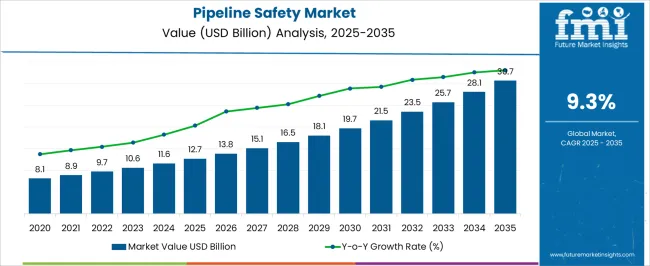
| Metric | Value |
|---|---|
| Pipeline Safety Market Estimated Value in (2025 E) | USD 12.7 billion |
| Pipeline Safety Market Forecast Value in (2035 F) | USD 30.7 billion |
| Forecast CAGR (2025 to 2035) | 9.3% |
The Pipeline Safety market is witnessing significant growth, driven by increasing global demand for secure, efficient, and environmentally compliant pipeline infrastructure. Rising investments in oil and gas transportation, coupled with regulatory requirements for operational safety, are fueling adoption of advanced pipeline monitoring and protection solutions. Technological advancements in sensors, automated monitoring, and real-time data analytics are enhancing pipeline integrity management while minimizing downtime and risk of leaks or accidents.
Service offerings, including consulting, maintenance, and training, are increasingly being leveraged to ensure adherence to safety standards and regulatory compliance. The integration of predictive analytics and AI-driven monitoring enables early detection of anomalies, reducing operational disruptions and environmental hazards.
Rising focus on natural gas, crude oil, and petrochemical pipeline safety, along with initiatives for sustainable and secure energy delivery, is further driving market expansion As pipeline networks grow and the complexity of operations increases, adoption of innovative technology solutions and expert services is expected to sustain long-term growth in the market.
The pipeline safety market is segmented by technology & solutions, service, vertical, and geographic regions. By technology & solutions, pipeline safety market is divided into Perimeter Intrusion Detection, Video Surveillance, Satellite Monitoring, Pipeline Monitoring System, Leakage Detection System, Secure Communication, Supervisory Control And Data Acquisition (SCADA) For Pipelines, Pig Tracking, Integrated Fiber Optics Monitoring, and Industrial Control System Security. In terms of service, pipeline safety market is classified into Consulting, Professional, Risk Management, Repair & Maintenance, and Integrity Management. Based on vertical, pipeline safety market is segmented into Natural Gas, Crude Oil, Refined Products, and Others. Regionally, the pipeline safety industry is classified into North America, Latin America, Western Europe, Eastern Europe, Balkan & Baltic Countries, Russia & Belarus, Central Asia, East Asia, South Asia & Pacific, and the Middle East & Africa.
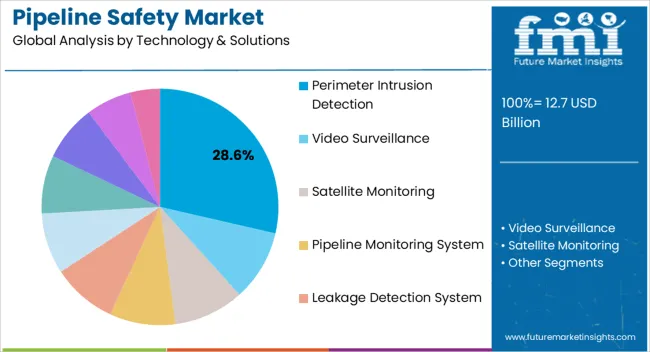
The perimeter intrusion detection segment is projected to hold 28.6% of the Pipeline Safety market revenue in 2025, establishing it as the leading technology and solutions category. Growth in this segment is being driven by the critical need to monitor and secure extensive pipeline corridors against unauthorized access, sabotage, and theft. Advanced detection technologies, including motion sensors, infrared systems, and AI-enabled analytics, are being integrated into pipeline infrastructure to provide real-time alerts and actionable intelligence.
These systems enable rapid response to potential threats, minimizing the risk of operational disruptions, environmental damage, and financial losses. Scalability and adaptability of these solutions across diverse pipeline environments further enhance adoption.
The ability to upgrade detection capabilities through software and integrate them with centralized monitoring systems provides additional operational efficiency As pipeline operators prioritize security and regulatory compliance, perimeter intrusion detection technologies are expected to maintain their leading position, supported by innovation in sensor performance and intelligent monitoring.
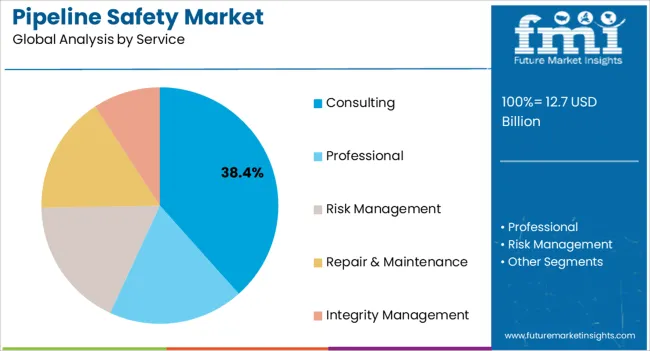
The consulting service segment is anticipated to account for 38.4% of the market revenue in 2025, making it the leading service category. Growth is being driven by the increasing complexity of pipeline safety regulations and the need for specialized expertise in risk assessment, compliance, and operational optimization.
Consulting services provide critical guidance on pipeline design, integrity management, incident prevention, and adherence to industry standards, reducing operational risks and potential liabilities. These services are increasingly complemented by training programs, audits, and technology advisory, enabling organizations to implement best practices and adopt advanced monitoring systems effectively.
The adoption of consulting solutions is further supported by regulatory scrutiny, increasing emphasis on environmental protection, and rising operational costs associated with pipeline failures As pipeline networks expand and safety requirements become more stringent, consulting services are expected to remain a primary driver of market growth, enabling operators to improve safety performance, optimize maintenance strategies, and ensure regulatory compliance efficiently.
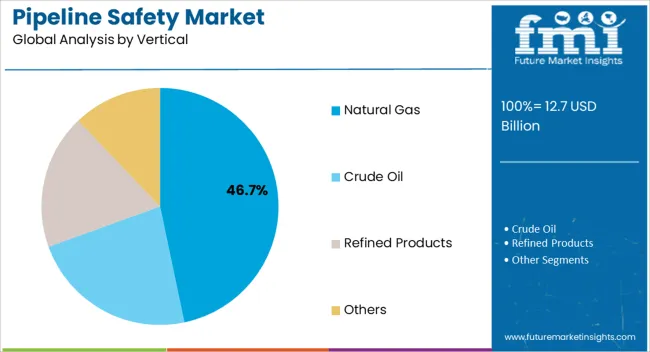
The natural gas vertical segment is projected to hold 46.7% of the market revenue in 2025, establishing it as the leading end-use category. Growth in this segment is driven by the rising global demand for natural gas as a cleaner energy source and the expansion of gas pipeline networks. Ensuring pipeline integrity and preventing leaks or operational failures is critical due to the flammable and high-pressure nature of natural gas transport.
Adoption of advanced safety technologies, monitoring solutions, and consulting services enables operators to mitigate risks, improve operational efficiency, and comply with stringent safety regulations. The segment benefits from investments in infrastructure modernization, smart pipeline monitoring systems, and AI-enabled predictive maintenance.
Increasing regulatory oversight and focus on environmental protection further reinforce the need for robust safety solutions in the natural gas vertical As natural gas consumption continues to grow worldwide, this segment is expected to remain the largest revenue contributor, supported by continuous innovation in safety technology and service offerings.
Pipelines are used to transport gas & liquid products to various locations and to users over long distance across the country. These pipelines are recognized as a safe & reliable means for transporting hazardous product over significant distance.
However, improper handling and distribution of these hazardous product may endanger human life and adversely affect the environment. The Transportation Security Administration, within the department of Homeland Security (DHS) is the lead agency for security & transportation including pipelines.
Increasing requirement of controlling and monitoring fluid dynamics in Oil & gas industry is expected to boost the demand for pipeline safety market over the forecast period.
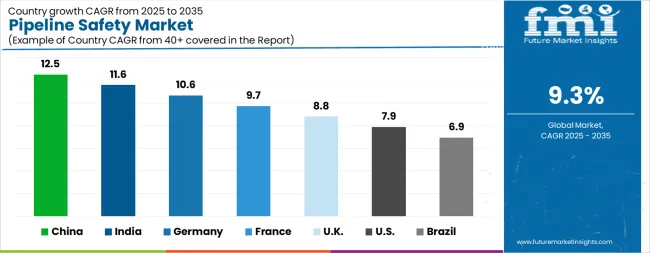
| Country | CAGR |
|---|---|
| China | 12.5% |
| India | 11.6% |
| Germany | 10.6% |
| France | 9.7% |
| UK | 8.8% |
| USA | 7.9% |
| Brazil | 6.9% |
The Pipeline Safety Market is expected to register a CAGR of 9.3% during the forecast period, exhibiting varied country level momentum. China leads with the highest CAGR of 12.5%, followed by India at 11.6%. Developed markets such as Germany, France, and the UK continue to expand steadily, while the USA is likely to grow at consistent rates. Brazil posts the lowest CAGR at 6.9%, yet still underscores a broadly positive trajectory for the global Pipeline Safety Market. In 2024, Germany held a dominant revenue in the Western Europe market and is expected to grow with a CAGR of 10.6%. The USA Pipeline Safety Market is estimated to be valued at USD 4.7 billion in 2025 and is anticipated to reach a valuation of USD 10.1 billion by 2035. Sales are projected to rise at a CAGR of 7.9% over the forecast period between 2025 and 2035. While Japan and South Korea markets are estimated to be valued at USD 673.8 million and USD 363.1 million respectively in 2025.
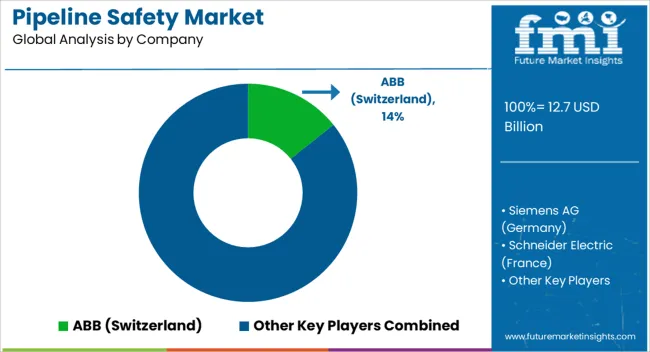
| Item | Value |
|---|---|
| Quantitative Units | USD 12.7 Billion |
| Technology & Solutions | Perimeter Intrusion Detection, Video Surveillance, Satellite Monitoring, Pipeline Monitoring System, Leakage Detection System, Secure Communication, Supervisory Control And Data Acquisition (SCADA) For Pipelines, Pig Tracking, Integrated Fiber Optics Monitoring, and Industrial Control System Security |
| Service | Consulting, Professional, Risk Management, Repair & Maintenance, and Integrity Management |
| Vertical | Natural Gas, Crude Oil, Refined Products, and Others |
| Regions Covered | North America, Europe, Asia-Pacific, Latin America, Middle East & Africa |
| Country Covered | United States, Canada, Germany, France, United Kingdom, China, Japan, India, Brazil, South Africa |
| Key Companies Profiled | ABB (Switzerland), Siemens AG (Germany), Schneider Electric (France), Baker Hughes (US), Honeywell (US), Huawei Technologies (China), AVEVA (UK), PSI AG (Germany), BAE Systems (UK), TransCanada (Canada), Atmos International (UK), Clampon AS (Norway), FFT (Australia), Perma-Pipe (US), and Senstar (Canada) |
The global pipeline safety market is estimated to be valued at USD 12.7 billion in 2025.
The market size for the pipeline safety market is projected to reach USD 30.7 billion by 2035.
The pipeline safety market is expected to grow at a 9.3% CAGR between 2025 and 2035.
The key product types in pipeline safety market are perimeter intrusion detection, video surveillance, satellite monitoring, pipeline monitoring system, leakage detection system, secure communication, supervisory control and data acquisition (scada) for pipelines, pig tracking, integrated fiber optics monitoring and industrial control system security.
In terms of service, consulting segment to command 38.4% share in the pipeline safety market in 2025.






Our Research Products

The "Full Research Suite" delivers actionable market intel, deep dives on markets or technologies, so clients act faster, cut risk, and unlock growth.

The Leaderboard benchmarks and ranks top vendors, classifying them as Established Leaders, Leading Challengers, or Disruptors & Challengers.

Locates where complements amplify value and substitutes erode it, forecasting net impact by horizon

We deliver granular, decision-grade intel: market sizing, 5-year forecasts, pricing, adoption, usage, revenue, and operational KPIs—plus competitor tracking, regulation, and value chains—across 60 countries broadly.

Spot the shifts before they hit your P&L. We track inflection points, adoption curves, pricing moves, and ecosystem plays to show where demand is heading, why it is changing, and what to do next across high-growth markets and disruptive tech

Real-time reads of user behavior. We track shifting priorities, perceptions of today’s and next-gen services, and provider experience, then pace how fast tech moves from trial to adoption, blending buyer, consumer, and channel inputs with social signals (#WhySwitch, #UX).

Partner with our analyst team to build a custom report designed around your business priorities. From analysing market trends to assessing competitors or crafting bespoke datasets, we tailor insights to your needs.
Supplier Intelligence
Discovery & Profiling
Capacity & Footprint
Performance & Risk
Compliance & Governance
Commercial Readiness
Who Supplies Whom
Scorecards & Shortlists
Playbooks & Docs
Category Intelligence
Definition & Scope
Demand & Use Cases
Cost Drivers
Market Structure
Supply Chain Map
Trade & Policy
Operating Norms
Deliverables
Buyer Intelligence
Account Basics
Spend & Scope
Procurement Model
Vendor Requirements
Terms & Policies
Entry Strategy
Pain Points & Triggers
Outputs
Pricing Analysis
Benchmarks
Trends
Should-Cost
Indexation
Landed Cost
Commercial Terms
Deliverables
Brand Analysis
Positioning & Value Prop
Share & Presence
Customer Evidence
Go-to-Market
Digital & Reputation
Compliance & Trust
KPIs & Gaps
Outputs
Full Research Suite comprises of:
Market outlook & trends analysis
Interviews & case studies
Strategic recommendations
Vendor profiles & capabilities analysis
5-year forecasts
8 regions and 60+ country-level data splits
Market segment data splits
12 months of continuous data updates
DELIVERED AS:
PDF EXCEL ONLINE
Pipeline Integrity Market Size and Share Forecast Outlook 2025 to 2035
Pipeline Monitoring System Market Size and Share Forecast Outlook 2025 to 2035
Oil Pipeline Infrastructure Market Size and Share Forecast Outlook 2025 to 2035
Gas Pipeline Infrastructure Market Size and Share Forecast Outlook 2025 to 2035
Data Pipeline Observability Solutions Market Size and Share Forecast Outlook 2025 to 2035
Virtual Pipeline Market Size and Share Forecast Outlook 2025 to 2035
Hydrogen Pipeline Market Size and Share Forecast Outlook 2025 to 2035
Offshore Pipeline Infrastructure Market Size and Share Forecast Outlook 2025 to 2035
Oil and Gas Pipeline Coating Market Forecast and Outlook 2025 to 2035
LNG Virtual Pipeline Market Size and Share Forecast Outlook 2025 to 2035
Oil and Gas Pipeline Management Software Market
District Heating Pipeline Network Market Size and Share Forecast Outlook 2025 to 2035
Non-alcoholic Steatohepatitis Drugs Pipeline Market Outlook 2025 to 2035
Safety Label Market Size and Share Forecast Outlook 2025 to 2035
Safety Bottle Tote Carriers Packaging Market Size and Share Forecast Outlook 2025 to 2035
Safety Towing System Market Size and Share Forecast Outlook 2025 to 2035
Safety Syringe Market Size and Share Forecast Outlook 2025 to 2035
Safety Actuators Market Size and Share Forecast Outlook 2025 to 2035
Safety Needles Market Size and Share Forecast Outlook 2025 to 2035
Safety Laser Scanner Market Size and Share Forecast Outlook 2025 to 2035

Thank you!
You will receive an email from our Business Development Manager. Please be sure to check your SPAM/JUNK folder too.
Chat With
MaRIA